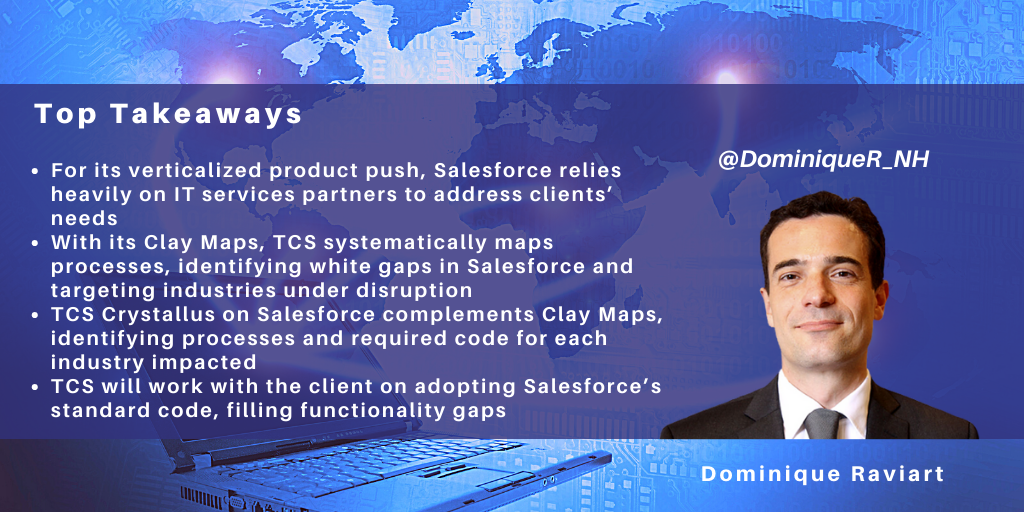Search posts by keywords:
Filter posts by author:
Related Reports
Related NEAT Reports
Other blog posts
posted on Jul 04, 2023 by Dominique Raviart

We recently talked with TCS’ Salesforce practice about its verticalization initiatives.
Product verticalization has been one of Salesforce’s key strategies (along with Customer 360/cross-selling and geographic expansion) since 2014, when it launched its Industries business unit. Like SAP, Salesforce acknowledges that organizations spend time and effort customizing their enterprise applications, and so it has broadened and deepened its vertical cloud offering, strengthened by its acquisition of Vlocity in 2020.
Despite its vertical push, Salesforce continues to rely on IT services partners to complement its vertical capabilities, acknowledging the role of its systems integration partners. Yet, the role of the service partner raises many questions about the nature of their vertical offering. Should a partner’s vertical offering be a product (sold with a subscription) or a solution (provided with the service)? Should it have functionality and an enhancement roadmap or be project-led? Should the partner offer point functionality, integrate with Salesforce applications, or provide a more comprehensive sub-vertical solution? Should the solution be available on AppExchange and go through Salesforce certification?
Our discussion with TCS’ Salesforce practice helped clarify what clients should expect and its verticalization effort with TCS Crystallus™ on Salesforce.
With Clay Maps, TCS combines a transformation methodology with systematic sub-process mapping
In the past two years, TCS has articulated its Salesforce verticalization strategy through its Clay Maps, which have two components:
- A systematic mapping of key sub-processes, targeting sub-verticals under disruption. The company has mapped these sub-processes with Salesforce functionalities across Clouds, going beyond erstwhile Vlocity to the full range of sectors (Salesforce Customer 360)
- A transformation methodology based on identifying the client’s goal and how this goal impacts the client’s business and, eventually, processes. TCS calls this their ‘go-to-market plays’. Examples include fraud prevention and detection for claims management in insurance and wellness insurance for healthcare payers.
TCS Crystallus: Adapting to Client Demand
Based on Clay Maps, and as part of its TCS Crystallus on Salesforce initiative, TCS created 90 artifacts ranging from PoVs to demos and solutions. Crystallus includes:
- For each sub-industry: a problem statement, impacted processes and code remediating the problem statement. TCS has ~30 of these go-to-market plays
- Approximately 30 pre-configured applications (based on TCS’ best practices) and 10 PoVs that eventually will become pre-configured applications
- 20 functionality white spaces for which TCS has developed reusable code components.
TCS Crystallus goes across telecom, media, technology, manufacturing, life science, healthcare, retail & CPG, public sector, E&U, BFS, travel & hospitality, and professional services.
TCS takes a pragmatic approach to its Crystallus artifacts: it will initially design PoVs, invest in a demo, and then a reference architecture and a solution, depending on client demand.
An example of a Crystallus sub-vertical solution is for healthcare providers. TCS has developed several roles such as the clinical educator journey, where the educator looks at patient records, enrolls the patient in care programs, and shares knowledge articles with patients. The Crystallus solution also provides dashboards and drill-down capabilities.
The company has designed a roadmap for its most successful solutions and will enhance them, primarily based on upfront investments rather than project-led developments. Overall, TCS provides the solutions as part of the service, although it does not rule out selling them for a subscription or a license if the client asks for the standalone solution.
TCS asserts it has also anticipated the future. Should Salesforce develop its own sub-vertical process or point solution, TCS will work with the client transitioning to the off-the-shelf functionality and remove dead custom code. TCS highlights that it has designed its TCS Crystallus solution as modular and will integrate with the client’s applications. The practice asserts that, as a top five Salesforce partner (based on certifications), it has access to Salesforce’s product roadmap, which it reviews.
TCS asserts that Crystallus is for the long term, and that further sub-vertical expansion is part of the journey. The company launches assets in the verticals brought by Vlocity/Salesforce Industry Cloud, e.g., in media, energy & utilities, and healthcare providers, with recent solutions for gas and energy transition and new Salesforce Cloud (e.g., CPG). TCS increasingly wants to design solutions across Salesforce products (‘multi-cloud’). Salesforce finds that the more Cloud products its clients have, the more loyal they are. This makes sense and correlates with Salesforce’s claims that its clients use it for creating a front-office platform. We think that clients will be even more loyal if they find sub-vertical Salesforce solutions that reduce customization work and maintenance costs.
